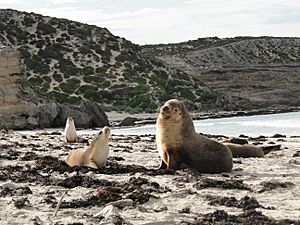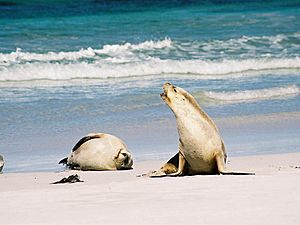Australian sea lion facts for kids
Quick facts for kids Australian sea lion |
|
|---|---|
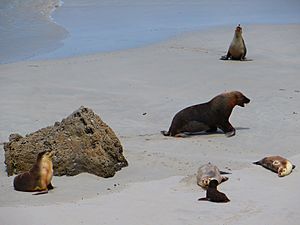 |
|
| Male Australian sea lion with a harem at Seal Bay Conservation Park, Kangaroo Island, South Australia | |
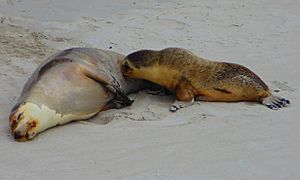 |
|
| Female Australian sea lion with pup at Seal Bay Conservation Park, Kangaroo Island, South Australia | |
| Conservation status | |
| Scientific classification | |
| Genus: |
Neophoca
|
| Species: |
cinerea
|
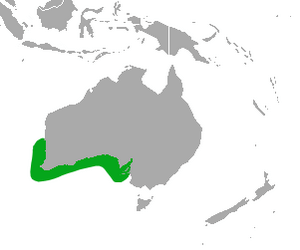 |
|
| Australian sea lion range | |
The Australian sea lion (Neophoca cinerea) is a special type of sea lion. It lives only in Australia. You might also hear it called the Australian sea-lion or Australian sealion.
Sadly, there aren't many Australian sea lions left. Experts think there are only about 14,730 of them. Because of their low numbers, they are listed as an endangered animal. This means they are at risk of disappearing forever.
Contents
- What Do Australian Sea Lions Look Like?
- How Big Are They?
- Where Do Australian Sea Lions Live?
- How Do They Talk to Each Other?
- What Do Australian Sea Lions Eat?
- Who Are Their Predators?
- How Do They Have Babies?
- How Many Australian Sea Lions Are There?
- What Threats Do They Face?
- How Are They Being Protected?
- Can They Be Bred in Zoos?
- See also
What Do Australian Sea Lions Look Like?
Male Australian sea lions are larger than females. Males are dark brown and have a yellow mane around their neck. Females are silver or fawn with a cream-colored belly.
These sea lions have short fur that helps keep them warm. They use their strong flippers to swim very fast in the water. They also use their flippers to move around on land.
How Big Are They?
Male Australian sea lions can grow quite large! They can be about 2.0 to 2.5 meters (6.6 to 8.2 feet) long. They can weigh between 250 to 300 kilograms (550 to 660 pounds). That's as heavy as a baby elephant!
Female Australian sea lions are smaller. They usually grow to be about 1.3 to 1.8 meters (4.3 to 5.9 feet) long. They weigh between 65 to 105 kilograms (143 to 231 pounds).
Where Do Australian Sea Lions Live?
These sea lions live along the southern coast of Australia. You can find them from the Houtman Abrolhos Islands in Western Australia to The Pages Islands in South Australia.
They mostly live on islands. But sometimes, they visit the mainland, like at Point Labatt in South Australia. A long time ago, they lived in more places. Now, their home range is smaller than it used to be.
How Do They Talk to Each Other?
Female sea lions and their pups have special ways to recognize each other. They use their sense of smell, sight, and hearing to know who is who.
Male Australian sea lions make three different kinds of sounds. They can bark, bleat (like a sheep), and even make a sound that sounds like a female sea lion.
What Do Australian Sea Lions Eat?
Australian sea lions are skilled hunters. They eat many different sea creatures. Their diet includes fish, squid, cuttlefish, octopus, and even small sharks. They also enjoy eating Southern rock lobster and other small crustaceans. Sometimes, they even catch Little penguins for a meal!
Who Are Their Predators?
Adult Australian sea lions can be hunted by large Great white sharks. Sometimes, other animals like stingrays can also harm them.
Young sea lion pups are more at risk. Smaller shark species can attack them.
How Do They Have Babies?

The time when Australian sea lions have their babies is called the breeding season. This season can last a long time, from five to seven months. At Seal Bay on Kangaroo Island, it has even lasted up to nine months!
Male sea lions, called bulls, do not have fixed areas during breeding. Young males start fighting early to show how strong they are. During the breeding season, the strongest males will guard females. This is so they can be the ones to have babies with them. Male Australian sea lions have also been known to harm young pups to protect their space.
Australian sea lions also show a special behavior called alloparental care. This is when an adult sea lion takes care of another sea lion's pup or pups. This might happen if the original parents die or get separated from their babies. This caring behavior is common and seen in many other animals, like elephants.
How Many Australian Sea Lions Are There?
In 2010, there were about 14,730 Australian sea lions. But by 2014, this number had dropped to around 6,500. Their population continues to get smaller. Because of this, they are listed as Endangered on the IUCN Red List.
The Australian sea lion population faces natural challenges. Their breeding cycle is long and complex. Females tend to stay in the same breeding spots. Also, many young sea lions do not survive. All these things make them more likely to become extinct.
Jones Island, west of Eyre Peninsula in South Australia, is one of the few places where their numbers are not going down. In 2019, this island was made a "prohibited area." This was done to stop people from disturbing the sea lion colony when they are on land.
In 2018, scientists started using aerial drones to find and count sea lion groups. This was along the Nullarbor Plain. Before, surveying these areas was hard. People had to use binoculars and look down 60-meter-high cliffs to see the rocks below. Drones make it much easier and safer.
What Threats Do They Face?
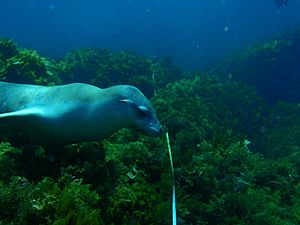
After Europeans settled in Australia, sea lions were hunted a lot. This greatly reduced their numbers. Large-scale hunting stopped in the 1920s. However, some hunting and trading of "hair seal" skins continued. We don't have exact numbers from before this hunting. But we know the species' population and where they live have both shrunk.
In the 20th and 21st centuries, the biggest dangers came from fishing. Sea lions could get caught in fishing nets or gear. Some were also shot illegally. Luckily, animals that get tangled can sometimes be found and helped.
Other threats include:
- Fish farming: This can lead to loss of their natural homes, entanglement, or direct harm.
- Diseases: Sickness can spread through their groups.
- Pollution: Trash and chemicals in the ocean can hurt them.
- Oil spills: These can cover their fur and make them sick.
- Noise: Loud noises from things like seismic surveys, construction, or boats can disturb them.
How Are They Being Protected?
Protecting the places where Australian sea lions have their babies has been a top goal since the early 1900s.
In 2005, the Australian sea lion was listed as Vulnerable under the Commonwealth Environment Protection and Biodiversity Conservation Act 1999. It is also listed as vulnerable in South Australia and Western Australia.
On June 11, 2013, a special plan was made to help the Australian sea lion. This plan looks at what the species needs to survive across its whole range. It also lists what actions need to be taken and who will do them. In November 2014, the International Union for the Conservation of Nature officially listed the species as Endangered.
| Jurisdiction | Legislation or Relevant List | Conservation Status | Population trend | Last assessed |
|---|---|---|---|---|
| Global | IUCN Red List of Threatened Species | Endangered | Decreasing | 2014 |
| Australia | EPBC Act 1999 | Vulnerable | 2005 | |
| South Australia | National Parks and Wildlife Act 1972 | Vulnerable | ||
| Western Australia | Biodiversity Conservation Act 2016 | Vulnerable |
Can They Be Bred in Zoos?
Some zoos and aquariums are helping by having captive breeding programs. This means they are trying to breed Australian sea lions in zoos. In 2006, it was reported that at least 41 pups had been born and raised in captivity since 1981. This species has been kept in aquariums since at least 1965. In 2015, a young Australian sea lion was found and considered for living in captivity to help with these programs.
See also
 In Spanish: León marino australiano para niños
In Spanish: León marino australiano para niños



